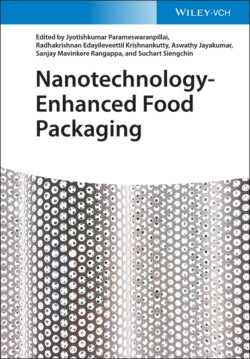Читать книгу Nanotechnology-Enhanced Food Packaging - Группа авторов - Страница 53
3.1.1 Starch Nanoparticles and Nanocrystals
ОглавлениеNanomaterials based on starch can be classified according to their nature in two main groups: starch nanoparticles (SNPs) and starch nanocrystals (SNCs). SNPs are almost completely amorphous particles that are commonly obtained by the controlled nanoprecipitation of gelatinized starch, while SNC synthetized through the hydrolysis of the amorphous phase of the starch granule, removing mostly amylose until nanosized particles are achieved [8, 9].
As mentioned before the synthesis of SNP materials is achieved mostly through nanoprecipitation of gelatinized starch, and most methods involve either hot or cold (addition of NaOH) gelatinization, which is followed by the addition of an anti-solvent, mostly ethanol, methanol, or acetone [10–13]. The anti-solvent methods involve the nucleation of the amylose molecules that precipitate once the anti-solvent is slowly added; this causes supersaturation in the solution and particle growth [14]. After the critical overlapping concentration is reached, nucleation starts and particles are formed. Furthermore, as nuclei are formed and growth supersaturation decreases, quickly a controlled process of growing nuclei is allowed [15]. In general, the anti-solvent method is considered simple, and the physicochemical properties of the SNP can be controlled by small changes in the process, such as the addition of surfactants [16] and changing the anti-solvent or the amylopectin/amylose ratios of the starch [16, 17]. Furthermore, aspects like the concentration of starch and process temperature are the important parameters affecting the yield of SNP [15, 18].
Extrusion has also been used as methods to synthetize SNP. In this method starch granules with limited amounts of water are subjected to high temperatures, pressures, and mechanical forces, thus undergoing changes such as melting, fragmentation, and incomplete gelatinization [15]. This process allows the disruption of the molecular bonds in the starch granules, forming smaller particles with less crystallinity [19]. Likewise, in reactive extrusion native starches are mixed with different reactants like plasticizers (glycerol, sorbitol, etc.) and cross-linkers and subjected to the extrusion process [20–22]. Starch fragments formed due to the extreme conditions are then cross-linked forming nanoparticles of different sizes. Furthermore, SNPs size can be reduced after addition of cross-linkers, as they increase the shear forces and torque, which facilitate size reduction [15].
Another mechanical technique used in SNPs formation is high-pressure homogenization [20]. This process, usually used in emulsion formation and microorganism inactivation, uses a continuous flow of liquid, which is subjected to external pressure sources and passed through microfabricated channels [23]. The mechanical forces reduce the size of particles breaking molecular bonds, obtaining very narrow size distributions [24]. Finally, gamma irradiation has also been used as a technique to reduce the starch granule size. In this technique a homogeneous starch paste is irradiated with gamma rays inducing breaking in the bonds of the amorphous regions, thus reducing particle size while maintaining crystallinity [25, 26]. Other methods include successive ultrasound treatments [27] and ball milling [28].
The methods for SNCs synthesis involve the hydrolysis of the amorphous, reducing particle size while increasing crystallinity. Most methods use acid hydrolysis, either with HCl or H2SO4; the later allows faster hydrolysis rates and higher yields, while HCl hydrolysis is more time consuming [29]. Reports have shown that SNCs can be obtained after 5–7 days using H2SO4, while using HCl this can take up to 15 days [11, 15, 30]. However, one of the main drawbacks of H2SO4 hydrolysis is that sulfate groups are incorporated into the SNCs surface; this can lead to increase stability in aqueous solution but can limit their applications in several fields [31].
In recent years, there has been an increasing need for green methods in SNCs synthesis that reduce the high amounts of hydrolyzing agent [14, 32]. Among this methods, enzymatic hydrolysis followed by acid hydrolysis has become one of the most important alternatives. Most examples use both α and β amylases as the hydrolyzing agent; the first one is a type of endo-amylase that hydrolyses internal α-1,4 bonds, while β-amylase is an exo-amylase that causes cleavage of alternated α-1,4 bonds from nonreducing ends [14]. Although amylases are an important part in starch digestion, it seems that using them by themselves is not enough for obtaining nanosized particles. Studies have shown that using only α-amylose as the hydrolyzing agent for waxy maize and rice starch results in starch particles of 11 and 3.6 μm, respectively [33, 34]. On the other hand, it has been shown that combined treatments of both enzymatic and acid hydrolysis can reduce synthesis time from seven to three days [6, 35]. Finally some physical methods have been used in combination with acid hydrolysis, such as ball milling and ultrasonication [36, 37].
